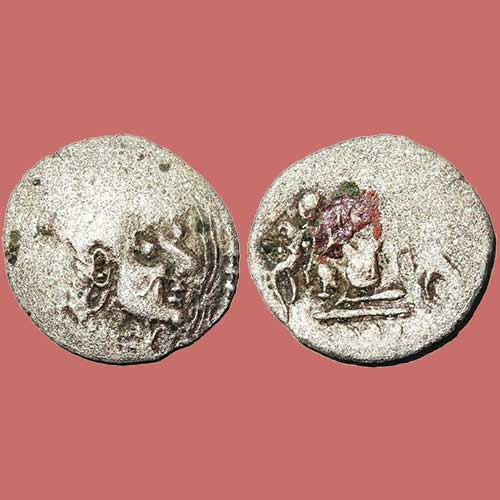Silver coin of Rastrakuta king
2019-11-05 Tue
As far as the discussion of the scholars on the coinage of the Rashtrakuta dynasty go, they have agreed about the various coins issued by the kings without the decipher title. These coins are a major part of the coinage studied today. But there are also coins issued by the anonymous Rashtrakuta rulers, whose title names are unknown. Many of these anonymous rulers issued the coins in gold. This anonymous coinage depicts one of the finest design and craftsmanship of the Rashtrakuta dynasty.The second silver coin illustrated in the above image weighs around 0.46g. It is an anonymous issue, attributed to the Rashtrakuta coinage. An elephant is depicted in the center, walking towards the right and it is mounted by a human figure (king/Mahout). A wheel or chakra is depicted at left with a dot in the center within the dotted border. The reverse of this coin depicts a seated goddess/ Garuda in the center seated in the padmasana posture. The figure's hair is tied high-up in a bun and halo is depicted with long ears with an un-deciphered eroded Brahmi legend around it.
It is understood that sometimes connecting coins to a certain ruler is difficult, so it becomes important to connect its attribute to a dynasty. In these circumstances, the script plays an important role. Hence, around the early medieval period, there was a transition from late Brahami to regional scripts like Sharda, Nagari, Telgu-Kannada, etc. The two types of transitions that can be seen in the script when focusing on the Rashtrakuta period, it is the transition of Gupta Brahmi to Nagari Script and Kadamba script to Telugu-Kannada Script.
Image Courtesy: Google Images
Latest News
-
Malwa Sultan Mahmud Shah Silver Coins
2025-09-11 ThuMalwa Sultan Mahmud Shah minted silver coins in round and square flans. <br><br> For round coins,...
-
Malwa Sultan Mahmud Shah Billon coin
2025-08-26 TueMalwa Sultan Mahmud Shah's billon coins followed three weight standards: 100 rati, 96 rati, and 80 r...
-
Fascinating Archaeological Facts on Postage Stamps - 91
2025-08-23 SatRhinoceros is one of the oldest land mammal species existing in India. There are five species of rhi...
-
Fascinating Archaeological Facts on Postage Stamps - 90
2025-08-23 SatUthiramerur, a Village in Kanchipuram, Tamil Nadu, is notable for its Temple inscriptions that descr...
-
Fascinating Archaeological Facts on Postage Stamps - 89
2025-08-21 ThuThe term “millet” is derived from the Latin word “milum,” which translates to grain. millets...

